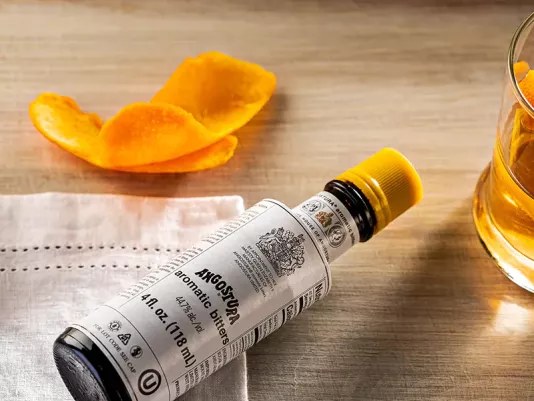Pumpkin Cocktail
Pumpkin Cocktail is a simple American cocktail recipe for the fall season.

Angostura Bitters is a concentrated aromatic extract that I have valued for many years for its ability to transform food and drinks. In my hands, it has always been more than just a bar ingredient. When I first tried the classic Old Fashioned cocktail, I was struck by how a few drops of Angostura could give the drink depth and character. Since then, I began actively experimenting with it in the kitchen. In my practice, it helps not only in cocktails but also in meat marinades, adds a spicy note to fruit salads, and even enhances the taste of chocolate desserts. Over the years, I developed my own approaches to using it: I know where it will be a harmonious accent and where I need to be more careful. I especially value its ability to balance sweet and bitter, creating a new level of flavor harmony.
Over many years of working with ingredients from different world cuisines, I learned to respect not only their taste but also their history. Angostura bitters date back to the early 19th century when they were created as an herbal medicinal tonic. For me, it has always been an example of how culinary art can combine tradition and modernity. In my practice, I have seen bartenders and chefs around the world interpret Angostura in their own way: some keep the classic style, adding it only to cocktails, while others boldly use it in desserts and sauces. I feel that its complex blend of herbs and spices makes it universal. It is important to remember: this bitters is very concentrated, and even a few drops can change the flavor of a dish. In my experience, it becomes the note that unites other ingredients into a harmonious symphony. When I make sauces for meat or vegetables, Angostura adds depth that is hard to replicate with other seasonings. I always emphasize: it should not dominate, its strength lies in highlighting, not overpowering, the taste.
In my work with bar culture, I always noted that Angostura is the heart of many classic cocktails. For example, Old Fashioned or Manhattan lack fullness without it. My experience shows: precision is key in cocktails – one or two drops can dramatically change the drink’s balance. Over the years, I developed a rule: better to add less and assess the taste than overdo it. I especially value this ingredient in combination with citrus juices: it reveals their brightness, creating a sense of freshness and noble bitterness. In my family, we even started a tradition: when we gather for holidays, I make a non-alcoholic cocktail with lemonade and a drop of Angostura – it adds complexity to the taste, and everyone looks forward to it. I also noticed that this bitters works wonderfully in hot drinks. Adding it to tea with orange zest or to mulled wine gives me a drink that warms not only the body but also the mood. This universal experience proves that Angostura goes far beyond the classic bar.
I always say: true cooking begins where we allow ourselves to experiment. Over years of preparing food, I discovered that Angostura works great not only for cocktails but also for meals. In my hands, it turned meat marinades into refined combinations of flavors: a few drops mixed with soy sauce, garlic, and honey make the meat tender and aromatic. My experience shows that it also works in desserts: I add it to chocolate mousse or cream, and then the dessert gains unexpected depth. I especially value it in fruit salads: it adds a slight bitterness that highlights the sweetness. In my practice, there were many times when guests were surprised that this very ingredient made the dish special. I always share the secret: do not be afraid to use Angostura where you usually add vanilla, cinnamon, or nutmeg. It opens a new level of taste, and this confirms my experience working with different cuisines of the world.
Over the years, I learned that a high-quality ingredient is half the success. When it comes to Angostura, I always recommend buying the original product. In my practice, there were cases when substitutes had a similar aroma but did not deliver the same depth of flavor. That is why I am convinced: only real Angostura deserves attention. As for storage, my experience shows that it is very stable. Thanks to its high alcohol concentration, it retains its properties for years. In my family, one bottle can sit on the shelf for several years, and the aroma remains just as rich. It is important to keep it in a dark place, away from direct sunlight. I always emphasize: even after years, the taste and aroma of Angostura remain stable, which makes it a reliable helper in cooking. This confidence comes with experience, and I always share it with those who are starting their journey in the world of flavors.
In my culinary practice, Angostura holds a special place. Over many years, I learned to use it as a universal tool for enhancing flavor. My experience shows: the main thing is not to be afraid of experiments. I remember when I first added a few drops to a cream sauce for pasta – the result exceeded expectations: the sauce gained a depth reminiscent of aged wine. I especially value Angostura in combination with chocolate: it is one of the most exquisite pairings I have discovered. In my family, we even make a chocolate cake with a secret ingredient – just a few drops of Angostura. Sometimes dishes can fail if you overdo the amount: the bitterness will be too pronounced. That is why I always emphasize: use this ingredient carefully, as its strength lies in balance. Over years of practice, I developed a simple rule: less is better. When you feel the harmony of flavor, you will understand the true magic of this bitters.